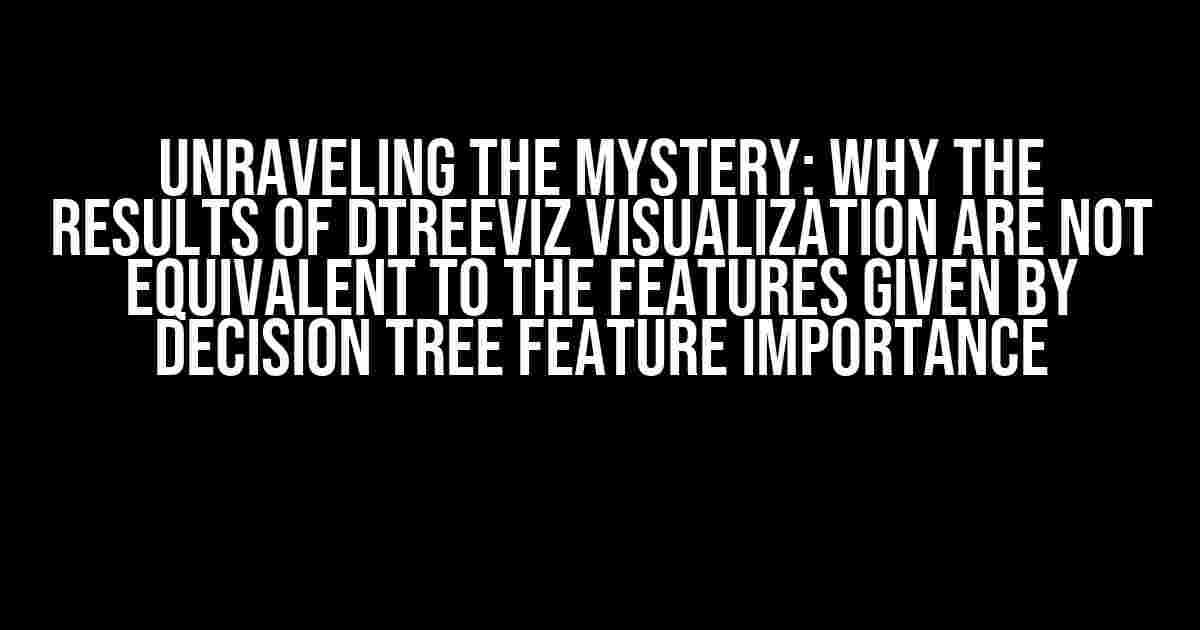Are you frustrated with the discrepancies between the results of dtreeviz visualization and the features given by decision tree feature importance? You’re not alone! Many data scientists and machine learning enthusiasts have encountered this issue, and it’s high time we demystify it. In this article, we’ll dive into the reasons behind this phenomenon and provide you with a comprehensive guide to understanding the differences between these two approaches.
What is dtreeviz Visualization?
dtreeviz is a popular Python library used for visualizing decision trees and their structure. It provides an elegant way to visualize the decision-making process and identify the most important features that contribute to the model’s predictions. The visualization helps data scientists and machine learning practitioners to:
- Identify the most informative features in the dataset
- Understand the decision-making process of the model
- Optimize the model’s hyperparameters
- Improve model interpretability
What is Decision Tree Feature Importance?
Decision tree feature importance is a measure of the contribution of each feature to the model’s predictions. It’s a built-in feature in many machine learning libraries, including scikit-learn, that provides a numerical value indicating the importance of each feature. The importance values are usually calculated using the Gini impurity or permutation importance methods.
Feature importance helps data scientists to:
- Identify the most relevant features in the dataset
- Remove irrelevant or noisy features
- Improve model accuracy and performance
- Enhance model interpretability
Why the Results of dtreeviz Visualization Are Not Equivalent to the Features Given by Decision Tree Feature Importance
Now that we’ve covered the basics of dtreeviz visualization and decision tree feature importance, let’s dive into the reasons why their results might not align:
1. Different Calculation Methods
The calculation methods used by dtreeviz and decision tree feature importance are different. dtreeviz uses a proprietary algorithm that takes into account the tree’s structure, feature interactions, and node importance, whereas decision tree feature importance uses Gini impurity or permutation importance methods.
# Calculate feature importance using scikit-learn
from sklearn.ensemble import RandomForestClassifier
from sklearn.datasets import load_iris
from sklearn.feature_importances_ import permutation_importance
iris = load_iris()
X, y = iris.data, iris.target
rf = RandomForestClassifier(n_estimators=100)
rf.fit(X, y)
importances = permutation_importance(rf, X, y, n_repeats=10)
print(importances)
2. Feature Interactions and Dependencies
dtreeviz takes into account feature interactions and dependencies, whereas decision tree feature importance often neglects these relationships. Feature interactions can significantly impact the model’s predictions, and ignoring them might lead to incorrect conclusions.
# Visualize feature interactions using dtreeviz
import dtreeviz
viz = dtreeviz.tree-viz(rf, X, y)
viz.view()
3. Model Complexity and Depth
The complexity and depth of the decision tree can influence the results of dtreeviz visualization and decision tree feature importance. More complex models might lead to noisy features being attributed higher importance, whereas simpler models might overlook important features.
# Control model complexity using scikit-learn
from sklearn.tree import DecisionTreeClassifier
dt = DecisionTreeClassifier(max_depth=5)
dt.fit(X, y)
print(dt.feature_importances_)
4. Data Distribution and Quality
The distribution and quality of the data can affect the results of both dtreeviz visualization and decision tree feature importance. Noisy or imbalanced data can lead to inconsistent results, and neglecting these issues might result in incorrect conclusions.
| Data Distribution | Impact on Results |
|---|---|
| Noisy data | Incorrect feature importance and visualization |
| Imbalanced data | Bias towards majority class and incorrect feature importance |
| High-dimensional data | Feature importance might be biased towards correlated features |
Best Practices to Ensure Consistent Results
To ensure consistent results between dtreeviz visualization and decision tree feature importance, follow these best practices:
- Use high-quality, clean, and well-distributed data
- Optimize model hyperparameters for complexity and depth
- Use a combination of feature importance methods (e.g., Gini impurity and permutation importance)
- Visualize feature interactions and dependencies using dtreeviz
- Regularly validate and cross-check results
Conclusion
In conclusion, the results of dtreeviz visualization and decision tree feature importance might not always align due to differences in calculation methods, feature interactions, model complexity, and data distribution. By understanding the underlying differences and following best practices, you can ensure consistent results and make informed decisions about feature importance and model optimization. Remember, there’s no one-size-fits-all solution, and it’s essential to combine multiple approaches to gain a comprehensive understanding of your model’s behavior.
Happy visualizing and optimizing!
Frequently Asked Question
Ever wondered why the results of dtreeviz visualization don’t quite add up to the features given by decision tree feature importance? Let’s dive into the reasons behind this discrepancy!
Q1: What’s the main difference between dtreeviz visualization and decision tree feature importance?
dtreeviz visualization is all about visualizing the decision tree’s structure, whereas decision tree feature importance provides a quantitative measure of each feature’s contribution to the tree’s predictions. These two methods serve different purposes, so it’s no surprise they don’t always align!
Q2: Does dtreeviz visualization take into account feature correlations?
Nope! dtreeviz visualization focuses on individual feature contributions, whereas decision tree feature importance considers feature correlations and interactions. This difference in approach can lead to discrepancies between the two results.
Q3: How does dtreeviz visualization handle feature interactions?
dtreeviz visualization doesn’t explicitly model feature interactions, unlike decision tree feature importance. This omission can result in visualizations that don’t fully capture the complexity of feature relationships.
Q4: Can I rely solely on decision tree feature importance for feature selection?
Not necessarily! While decision tree feature importance provides valuable insights, it’s essential to consider multiple evaluation metrics and techniques to ensure a comprehensive understanding of feature contributions.
Q5: What’s the best way to combine dtreeviz visualization and decision tree feature importance?
By using both methods in conjunction, you can gain a more complete understanding of your decision tree’s behavior! Visualize the tree’s structure with dtreeviz, and then use feature importance to quantify the contributions of each feature.
